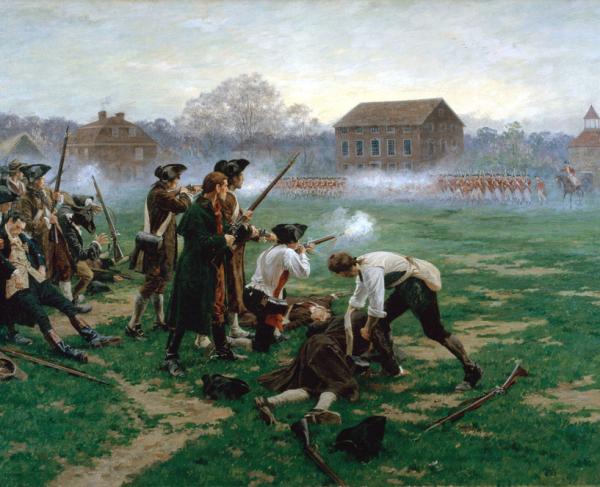
Lexington & Concord: 1775 Perspectives Lesson Plan
A lesson plan for use in middle and high school classrooms.
British soldiers, under orders from General Thomas Gage, marched out of Boston commanded by Lieutenant Colonel Francis Smith with Major John Pitcairn as second-in-command. Their mission, which Gage hoped to be cloaked in secrecy, was to confiscate and destroy the military supplies secreted in Concord.
On the route that was chosen to reach Concord, the British had to pass through the town of Lexington. With the sun peeking in the east on April 19, 1775, approximately 80 militiamen gathered on the green as the British approached. Parker ordered the men into a parade ground formation as the British changed their course. The redcoats marched onto Lexington Green with the added hope of disarming the militia and calling for them to disperse. In the nervousness of the moment, someone fired a musket. Then the British retaliated in the form of a volley and surged forward in a bayonet attack. The melee was soon over, with eight Lexington militiamen killed and another ten wounded before the rest panicked and fled. Only one British soldier was struck, wounded in the thigh. Order was restored soon after and with the arrival of the rest of Smith’s column, the light infantry fired a victory volley before resuming the march on to Concord.
When the British arrived in Concord, some searched nearby farms while others held the town. Militia companies waited near the Old North Bridge and observed. With smoke wafting in the air, the Patriots feared that the British were burning the town. Colonel Barrett ordered the militia to load their muskets and advance toward the bridge but implored them not to fire first. The British, seeing the advance, retreated to a position across the bridge on the town side. And then, a musket discharge reverberated. The now-famous “shot heard around the world” had been discharged. The British and Americans now both fired. Pandemonium erupted in the British lines, and the men hastily retreated toward town. The British officers ordered a return to Boston, which devolved into a rout as the British were continually ambushed by Minute Men shooting from behind trees, rock walls, and buildings along Battle Road. British reinforcements reach Smith and Pitcairn’s men on the eastern outskirts of Lexington, but the Americans pursue them until they reached Boston.
This Lesson Plan can be used as a prepared resource by following this curriculum plan which aligns to NCSS and Common Core Standards.
This Lesson Plan's assets can also be used on their own as supplemental resources. The display format is prepared for easy access, exploring, and learning.
1775 Perspectives Module
Upon completion of this lesson, the students will be able to:
- Knowledge
- Briefly explain the events at Lexington and Concord on April 19, 1775, that started the American Revolution.
2. Comprehension/Application/Analysis
- Examine multiple primary sources to better understand the events of the historic day and what it meant for the people involved.
3. Evaluation
- Discuss findings from primary sources and consider the outcomes of the fighting at Lexington and Concord.
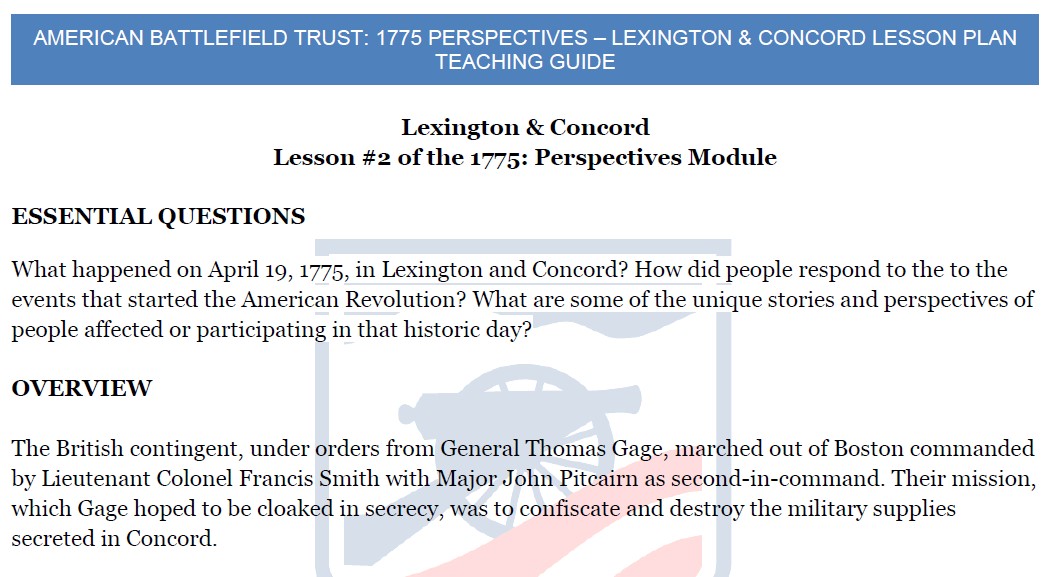
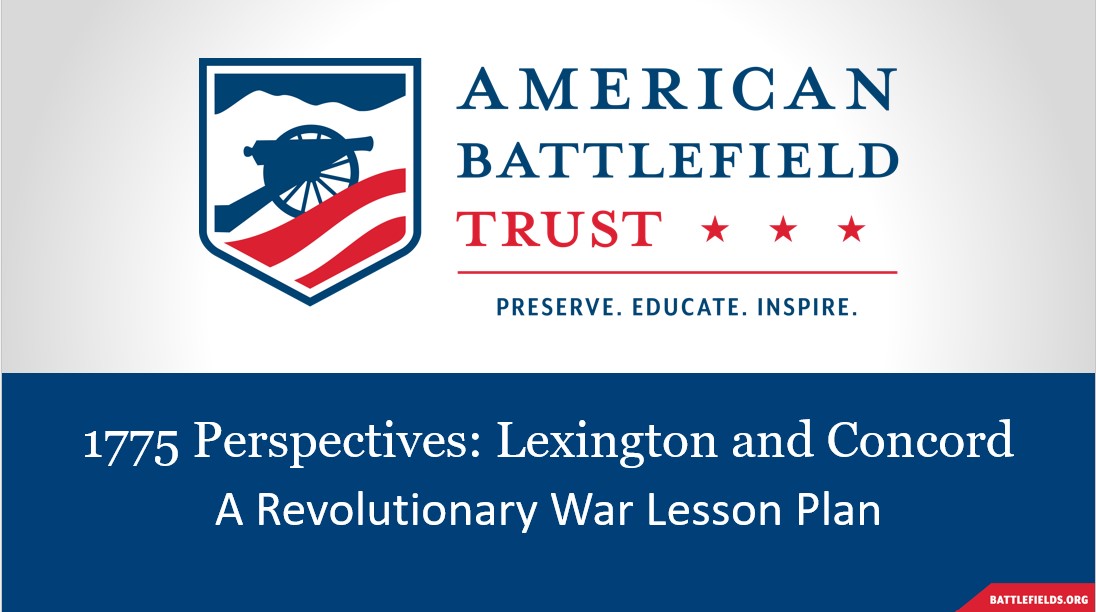
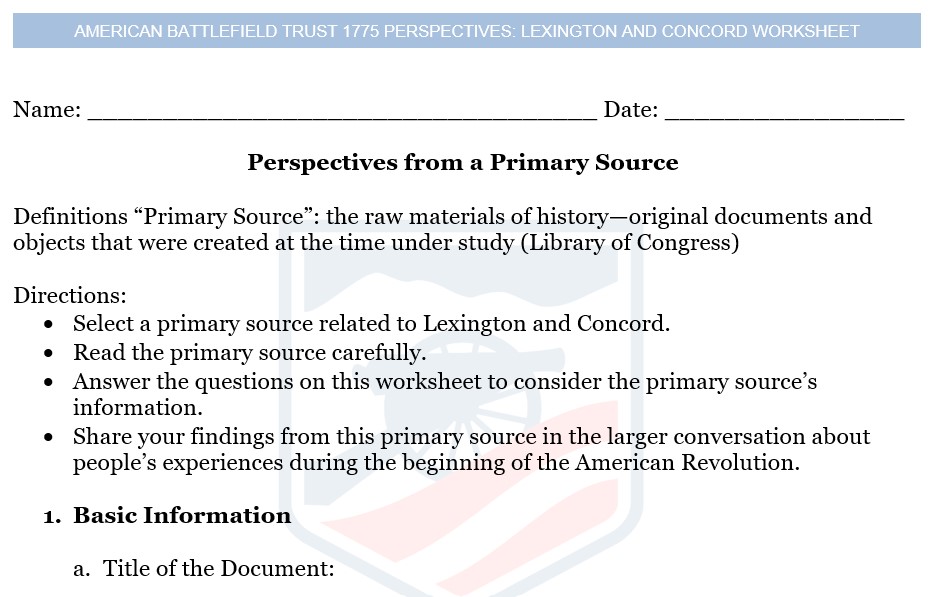
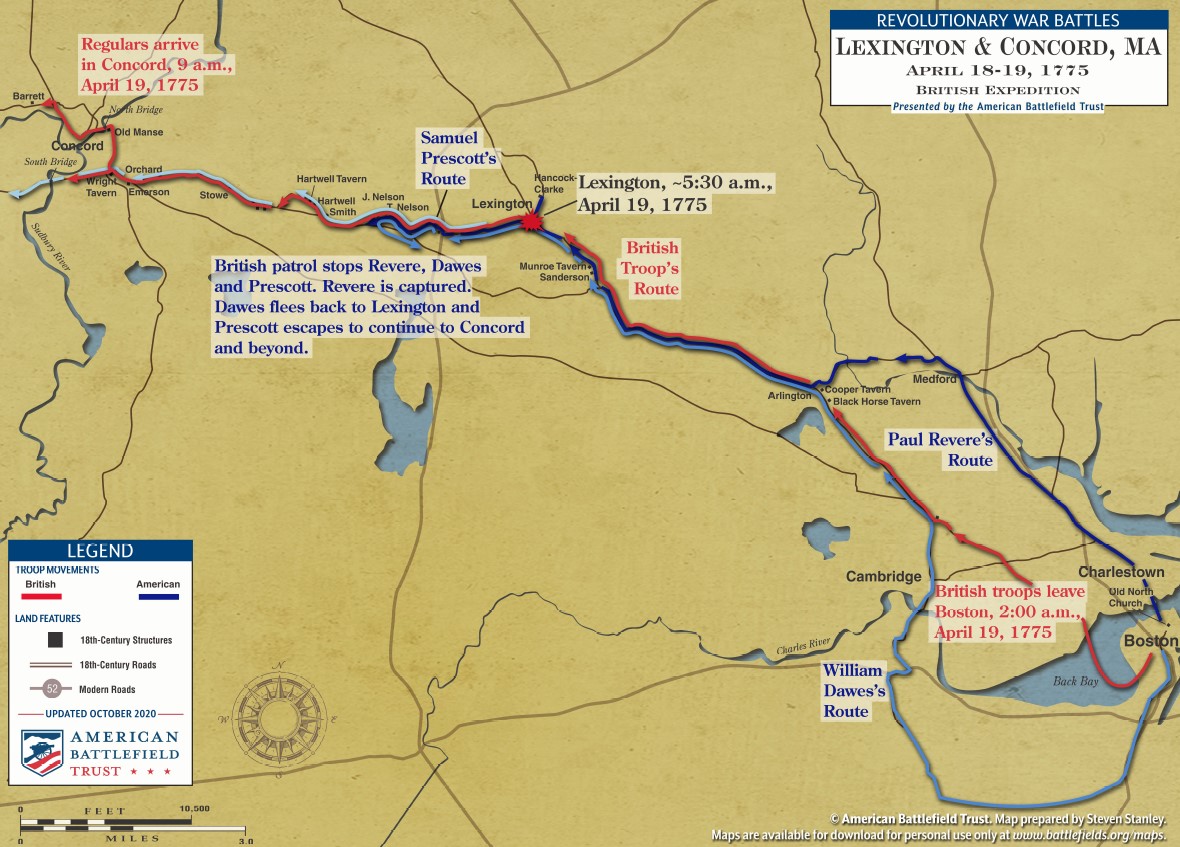
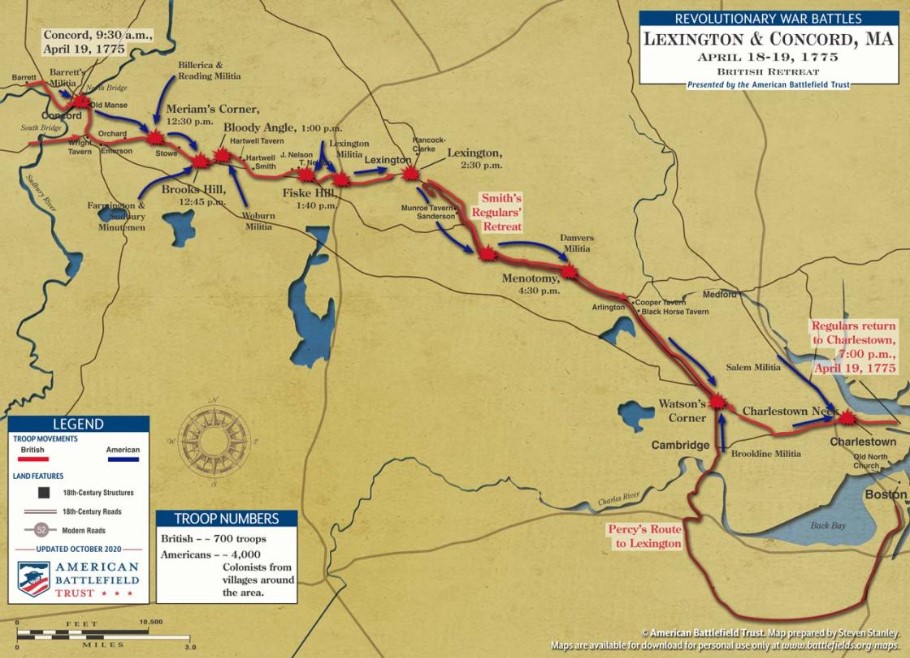
Check out the Lesson Plan Teaching Guide for more instructions on using the prepared Lesson Plan.
Lesson Plan Primary Source Activity:
- Use the Lesson’s PowerPoint to explore the context and history; the PowerPoint introduces context and foundational knowledge for exploring stories and accounts of April 19, 1775.
- Distribute or show in large size the maps of the British expedition’s advance and retreat and the movements of the American militia.
- The primary sources for this perspectives lesson plan offer multiple perspectives on different events; students can be divided into groups to read and fill out the worksheet.
| Lexington and Concord | A Deposition of Colonial Militiamen from the Battle of Lexington and Concord |
| "I Heard The Guns" | |
| Loyalist Woman's Account of Lexington and Concord | |
| "Several Letters Arrived at New-York, dated April 21, 1775" | |
| "Describing the Events that Took Place at Lexington and Concord“ | |
| The American Crisis (1775) |
- Distribute the lesson’s worksheet.
- Students will read a primary source and fill out the worksheet which will guide them through exploring the document.
- Encourage a class discussion and draw group conclusions, answering the questions:
- What were the goals of the April 19, 1775, for the British and the Massachusetts militiamen?
- Do you notice any personal statements of goals in the primary sources?
- Are there evidences of propaganda perspectives in the primary sources? What might be the purpose behind this?
- What did the incidents that led to the “Shot Heard ‘Round the World” mean to the participants and eyewitnesses that day? What does the phrase symbolize or mean to you?
OPTIONAL HOMEWORK/ASSESSMENT/ADDITIONAL ACTIVITIES:
Option 1: Biography Study
Have the students selected a historical person connected to the Battles of Lexington and Concord. (There are eight biography articles already prepared on the Lesson Plan Page). The students will read the biography and make notes for the following topics. Students can write a short essay, share their findings verbally, or incorporate their findings into a larger class project that might include art, costumes, or props.
Key Life Events:
Identify and describe three key events or milestones in the life of the individual. How did these events shape or influence their character, achievements, or contributions?
Role during the Battles of Lexington and Concord
What did this person do or observe on April 19, 1775? Does this seem to be a significant moment in this person’s life?
Legacy and Impact:
Reflect on the individual's legacy and impact on society. What are the person's major contributions or accomplishments? Do you think these accomplishments were good? How have their actions influenced the course of history or inspired others?
Option 2: Comparing British Soldiers & Massachusetts Militia
What were some similarities and differences between British soldiers and Massachusetts militiamen in April 1775?
View or read these resources:
- Citizen-Soldier video (2 minutes)
- What is a Minuteman?
- British Army in Boston
- British Army during the American Revolution
Students can create comparison lists or a Venn Diagram to examine the similarities and differences. How might these have contributed to the conflicts at Lexington and Concord?
If time permits, students can compare the lives of American militia leaders (Parker, Barrett, Davis) with the lives of British Officers (Smith, Pitcairn, Percy). There are biographies listed on the Lesson Plan Page.
Common Core State Standards- ELA & History/Social Studies
Grades 6-8
- Key Ideas and Details:
- CCSS.ELA-LITERACY.RH.6-8.1
- Cite specific textual evidence to support analysis of primary and secondary sources.
- CCSS.ELA-LITERACY.RH.6-8.2
- Determine the central ideas or information of a primary or secondary source; provide an accurate summary of the source distinct from prior knowledge or opinions.
- CCSS.ELA-LITERACY.RH.6-8.1
- Craft and Structure:
- CCSS.ELA-LITERACY.RH.6-8.6
- Identify aspects of a text that reveal an author's point of view or purpose (e.g., loaded language, inclusion or avoidance of particular facts).
- CCSS.ELA-LITERACY.RH.6-8.6
- Integration of Knowledge and Ideas:
- CCSS.ELA-LITERACY.RH.6-8.8
- Distinguish among fact, opinion, and reasoned judgment in a text.
- CCSS.ELA-LITERACY.RH.6-8.8
Grades 9-10
- Key Ideas and Details:
- CCSS.ELA-LITERACY.RH.9-10.1
- Cite specific textual evidence to support analysis of primary and secondary sources, attending to such features as the date and origin of the information.
- CCSS.ELA-LITERACY.RH.9-10.2
- Determine the central ideas or information of a primary or secondary source; provide an accurate summary of how key events or ideas develop over the course of the text.
- CCSS.ELA-LITERACY.RH.9-10.3
- Analyze in detail a series of events described in a text; determine whether earlier events caused later ones or simply preceded them.
- CCSS.ELA-LITERACY.RH.9-10.1
- Craft and Structure:
- CCSS.ELA-LITERACY.RH.9-10.5
- Analyze how a text uses structure to emphasize key points or advance an explanation or analysis.
- CCSS.ELA-LITERACY.RH.9-10.6
- Compare the point of view of two or more authors for how they treat the same or similar topics, including which details they include and emphasize in their respective accounts.
- CCSS.ELA-LITERACY.RH.9-10.5
- Integration of Knowledge and Ideas:
- CCSS.ELA-LITERACY.RH.9-10.8
- Assess the extent to which the reasoning and evidence in a text support the author's claims.
- CCSS.ELA-LITERACY.RH.9-10.9
- Compare and contrast treatments of the same topic in several primary and secondary sources.
- CCSS.ELA-LITERACY.RH.9-10.8
Grades 11-12
- Key Ideas and Details:
- CCSS.ELA-LITERACY.RH.11-12.1
- Cite specific textual evidence to support analysis of primary and secondary sources, connecting insights gained from specific details to an understanding of the text as a whole.
- CCSS.ELA-LITERACY.RH.11-12.2
- Determine the central ideas or information of a primary or secondary source; provide an accurate summary that makes clear the relationships among the key details and ideas.
- CCSS.ELA-LITERACY.RH.11-12.3
- Evaluate various explanations for actions or events and determine which explanation best accords with textual evidence, acknowledging where the text leaves matters uncertain.
Craft and Structure:
- Evaluate various explanations for actions or events and determine which explanation best accords with textual evidence, acknowledging where the text leaves matters uncertain.
- CCSS.ELA-LITERACY.RH.11-12.6
- Evaluate authors' differing points of view on the same historical event or issue by assessing the authors' claims, reasoning, and evidence.
- CCSS.ELA-LITERACY.RH.11-12.1
- Integration of Knowledge and Ideas:
- CCSS.ELA-LITERACY.RH.11-12.8
- Evaluate an author's premises, claims, and evidence by corroborating or challenging them with other information.
- CCSS.ELA-LITERACY.RH.11-12.9
- Integrate information from diverse sources, both primary and secondary, into a coherent understanding of an idea or event, noting discrepancies among sources.
- CCSS.ELA-LITERACY.RH.11-12.8
Social Studies - National Council for the Social Studies
- Theme 2: Time, Continuity, and Change
- Theme 3: People, Places, and Environments
- Theme 4: Individual Development and Identity
- Theme 5: Individuals, Groups, and Institutions
- Theme 6: Power, Authority, and Governance
- Theme 9: Global Connections
This Lesson plan
contains the following:
3 Activities | 28 Resources
Audience: Middle school | High school
